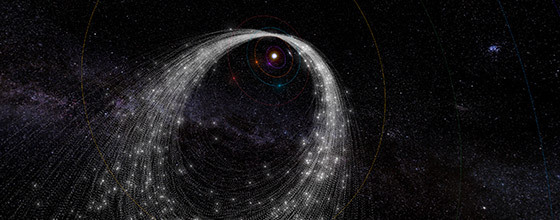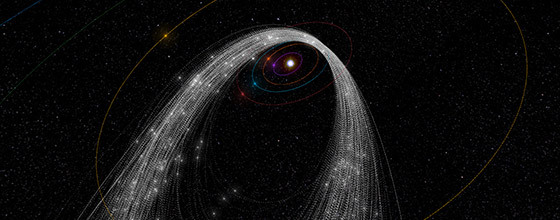.
The dusty debris streams that cause meteor showers are much more complex than scientists had thought: They warp and change on their trips around the sun, rather than following one path, close observation has revealed.
These dramatic shifts are clearly apparent in a new animation, which uses crowdsourced footage that tracks meteoroid trajectories through the sky to plot more than 45 meteor showers and their debris' paths through the solar system.
You can click and drag to view the Omicron Eridanid meteor shower's path in the applet below, or view the full set of them here:
Meteor showers occur when Earth passes through dust and debris left along the orbits of asteroids and comets that traverse the solar system. This debris burns up in Earth's atmosphere, producing shooting stars in the sky. [How Meteor Showers Work (Infographic)]
On a given night, all of the meteors from a meteor shower seem to be streaking away from a specific point in the sky, called the radiant, which many observers assume is constant for each meteor shower. (For instance, the Perseids appear to emanate from the Perseus constellation during their peak.) However, the new work shows how meteors' apparent sources seem to wander throughout a shower, and why these shooting-star displays can last for so long.
"It's the first time it's really well-documented, and the first time it's officially displayed [so] you can actually see how a stream looks in space as part of the solar system," Peter Jenniskens, an astronomer at the SETI (Search for Extraterrestrial Intelligence) Institute and NASA's Ames Research Center, both of which are located in California's Silicon Valley, told Space.com.
Jenniskens heads the Cameras for Allsky Meteor Surveillance (CAMS) project, which marshals low-light video cameras (many of which are ordinary security cameras) across the world to document meteor showers. The network has recorded more than 300,000 meteoroid trajectories since it started observing in 2010.
By combining all of the trajectories, researchers were able to visualize the meteoroid streams of comets (and some primitive asteroids) in the solar system and figure out how the streams' paths warp and change the approach direction at different points along the Earth's path every year, causing showers to wander through the sky. And the actual measured data is contained within the new animations.

Meteor showers move across the sky in part because the Earth is moving in a curved orbit as it passes through the stream of debris. But that's far from the full story, Jenniskens said.
"When I plotted out the maps with the Earth motion taken out, I noticed that some meteor showers would stay put — they would come from a certain direction, they would get intense for a couple of days, they would peak and then they would fade, and [their position in the sky] would not move," Jenniskens said. "But it turns out that a number of showers were moving, and that was quite interesting to see in the animations."

Some of the most extreme changes came from short-period meteor showers such as the Kappa Cygnids and the Omicron Eridanids, whose objects have relatively short orbits that loop past Earth and out near Jupiter. Those streams are stretched and warped so the meteor showers' radiants move dramatically across the sky over the few months' duration of each shower.
The effect likely comes from the tug of planets on the objects creating the streams, Jenniskens said. The spots where these objects' orbits cut through the plane of the planets change over time, and the pull of Jupiter at the outer end of their orbits changes their closest approach to the sun, too. Those effects in combination mean the stream takes on a skewed shape and the meteor shower moves across the sky, and also that Earth stays within the stream longer.
Longer-period meteor showers whose orbits venture further out show some change, too, even though their orbits are less perturbed by Jupiter — such as the famous Perseid meteor shower, which is generated by the debris strewn behind Comet Swift-Tuttle. During their peak, the Perseids appear to emanate from the constellation Perseus, but the meteor shower's source wanders slightly as well near the beginning and end of the shower (even when Earth's movement is taken into account). [Perseid Meteor Shower: Amazing Photos by Skywatchers]
In all, 18 short-period and 27 longer-period showers wander from night to night (and there are more to be discovered in the Southern hemisphere, Jenniskens said). Some showers don't wander, Jenniskens added — and whether and how a meteor shower wanders holds clues to how old the stream is and how it was created.
Jenniskens hopes that the visualization will inspire more amateur astronomers to participate in the surveillance studies. The places covered are listed online on the CAMS website, and the research team particularly needs more coverage triangulating meteor showers in the Southern Hemisphere. Many meteor showers only appear for a short period of time, like a few hours, some only appear in certain years, and sometimes weather gets in the way, so the more observers the more data can be gathered.
"It's a long process to get enough regions observed to really see all the meteor showers in detail — it's now coming of age, and you can really create these maps and see what's going on," Jenniskens said.
"What we need to do now is learn how to read that book, how to understand the streams," he added.
The new work, reviewing what has been measured about meteor showers during low-light camera surveys, has been accepted for publication in the journal Planetary and Space Science, according to a statement.
Quelle: SC
